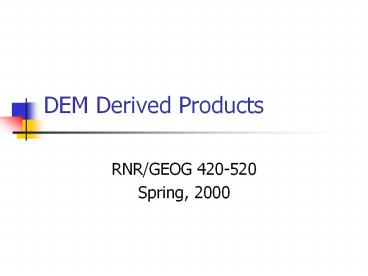DEM Derived Products PowerPoint PPT Presentation
1 / 27
Title: DEM Derived Products
1
DEM Derived Products
- RNR/GEOG 420-520
- Spring, 2000
2
DEMs and Derived Products
- Derived Products are Nearly Always Raster Based
- Based on Principles of Map Algebra and
Cartographic Modeling - Can be Divided into Point and Area Operations
3
Point Functions
- Computes an output grid in which the output value
at each location is a function of the input value
at each location - Accept grids, numbers and scalars as input
- Called Local Functions in GRID
4
Point Operations in GRID (contd.)
- Trigonometric
- Logarithmic
- Reclassification
- Selection
- Logical
- Statistical
5
Spatial Operations
- Interpolation
- Spatial Filtering
- First and Higher Order Derivatives
- Surface Topology Drainage Networks and
Catchment Delineation - Contiguity Assessment Clumping
- Cost Surface Calculation Non-Linear Dilation
- Visibility Analysis, Shaded Relief, Irradiance
6
Spatial Filters
Total
Range
Diversity
Mean
Min
Max
Mode
Std. Dev.
7
Spatial Filters in ARC/INFO
- Focal Functions
- compute an output grid based on input cell(s) in
a specified neighborhood of the location - Focalflow, majority, max, mean, median, min,
range, std, sum, and variety
8
Spatial Filters in ARC/INFO
- Zonal Functions
- These functions compute statistics or identify
features on the values from the value grid that
intersect the zones defined by a zone grid - Zonal Functions same as Focal Functions
Zone GRID
Value GRID
9
Low Pass Filter
- Low Pass Filter smoothes the entire DEM and
reduces the significance of anomalous cells - Mean filter for continuous surfaces
- Mode filter for nominal data
- FILTER ltin_latticegt ltout_latticegt LOW HIGH
FILE iterations filter_file
Mean
Mode
10
High Pass Filter (Edge Filter)
- Original Surface minus Low Pass Surface equals
High Pass surface - Has the effect of enhancing areas of rapid change
or complexity -- Edges - FILTER ltin_latticegt ltout_latticegt LOW HIGH
FILE
11
Measures of Relief
- Relief calculated with combinations of focalmin,
focalmax, and focal range - DOCELL
- temp focalmin (dem, circle, 5, data)
- relief dem - temp
- end
Relief Above max Target 950 810
140 Relief Below Target Min 810 780
30 Range max min 950 780 170
12
Measure of Roughness
- Terrain roughness can be seen as a factor of
elevation change, and measured as standard
deviation within a neighborhood - roughness focalstd (DEM, circle, 5, data)
Std. Dev.
13
Using Volume to Gauge Exposure
- Measured by passing an imaginary cylinder at a
set height over each cell - Cylinders with high volume are exposed, cylinders
with low volume are sheltered
14
Making a Shelter Grid
/making a grid with all cells equal to 1killme
(dem 0) 1/ making the shelter
gridDOCELL temp1 focalsum (killme,
circle, radius, data) temp2 (dem 20)
temp1 temp3 focalsum (dem, circle,
radius, data) sheltergrid temp2 -
temp3end
15
Slope and Aspect in GRID
- GRID fits a plane to the local neighborhood
- The angle and direction of the plane supply slope
and aspect measurements
16
A Problem With Aspect
- Aspect is measured in Degrees
- 1 degree and 359 degrees are essentially the same
aspect - The value 359 is much greater than the value 1
17
North South Aspect Grid
- DOCELLif (aspect gt 180) aspectNS - aspect
360 else aspectNS aspect360END
18
Slope and Aspect for TINs
- TINs must be converted to obtain slope and aspect
values - Conversion to a lattice allows GRID commands for
slope and aspect - TINARC with poly option converts to polygons that
carry slope and aspect values
- PAT for polygon created with TINARCAREA
6811.91209PERIMETER 553.27638TINPOLY
5TINPOLY-ID 4PERCENT_SLOPE
14.822ASPECT 260.762SAREA
6886.33275
19
Hydrologic Modeling
- DEMs allows automated modeling of hydrology
- Hydrologic modeling is a process that begins with
a DEM - Types of models flow direction, flow
accumulation, watershed delineation, and flow
length
20
(No Transcript)
21
Flow Direction
- Calculates flow direction for every cell in the
GRID - Based on direction of steepest slope in local
neighborhood - Several rules address potential problems
- FLOWDIRECTION(ltsurface_gridgt, o_drop_grid,
- NORMAL FORCE)
22
SINK
- Sinks are bad!
- GRIDs SINK command creates a grid identifying
all areas of internal drainage, i.e. sinks - SINK(ltdir_gridgt)
- GRIDs FILL command fixes sinks
23
Flow Accumulation
- Based on flow direction grid
- Creates a grid of accumulated flow to each cell
- Can be used to create a stream network
- FLOWACCUMULATION (ltdir_gridgt, weight_grid)
24
Flow Accumulation -gt Streams
- Use a conditional statement to create a stream
network from a flow accumulation grid - streams con (flow gt 100, 1)
25
Delineating Watersheds
- Determines the contributing area above a set of
cells in a grid - Needs a flow direction grid and sources
- WATERSHED (ltdir_gridgt, ltsource_gridgt)
- BASIN
- SNAPPOUR
26
Flowlength
- Calculates distance along a flow path for each
cell - Goes either upstream (to the nearest ridge) or
downstream (to the nearest sink or outlet) - Primary use is to determine the length of the
longest flow path in a basin - FLOWLENGTH (ltdir_gridgt, weight_grid,
DOWNSTREAM UPSTREAM)
27
Visibility Analysis
- Requires
- DEM
- Viewpoint/s
- What it tells you
- Line of sight
- Viewshed
- Combined Viewshed
- Cumulative Viewshed
Tall al-Umayri

